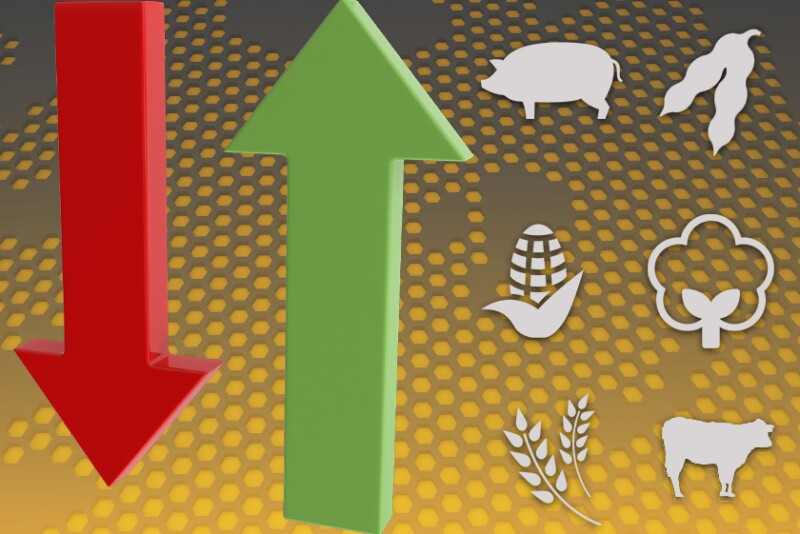GRAIN CALLS
Corn: 6 to 8 cents higher.
Soybeans: 14 to 18 cents higher.
Wheat: Steady to 10 cents higher.
GENERAL COMMENTS:
Corn and soybean futures rose overnight after unexpected declines in USDA’s latest crop condition ratings raised questions over the size of this fall’s harvest. Spring wheat futures led other wheat classes higher following further deterioration in crop ratings. Nymex crude oil futures are near unchanged, while the U.S. dollar index is slightly weaker this morning.
The Northern Plains and western Corn Belt are facing heat advisories and excessive heat warnings, with temperatures are expected to climb well into the 90s or 100s Fahrenheit. Most of the corn crop has completed pollination, but the forecast does raise some concern about grain fill. High temperatures are expected to ease Thursday when a front moves in.
Consultant Michael Cordonnier maintained his U.S. corn yield projection of 175.5 bu. per acre this week, noting that with the exception of the northwestern Corn Belt, “most of the corn has had a good July with adequate moisture and moderate temperatures,” he said in a report. Cordonnier also stuck with his U.S. soybean yield projection of 50 bu. per acre, with a neutral bias.
Cordonnier reduced his corn harvest projection for Brazil by 2 million metric tons (MMT), to 86 MMT, citing frost damage to the late-planted safrinha crop and another expected cold snap. “It is uncertain if farmers will be able to sell some of the poorest quality corn,” he says. Cordonnier expects Brazil’s corn exports to be closer to 20 MMT than USDA’s 28 MMT projection.
Refinitiv trade data shows Brazil exported 1.7 MMT of soymeal during June, just off the May record. Ship lineup data shows the country will likely export 1.69 MMT of soymeal this month. Brazil’s year-to-date (YTD) soymeal exports of 9.07 MMT top last year’s record. In contrast, Argentine soymeal exports have held at five-year lows since May, with 1.6 MMT of the soy byproduct shipping during June and 1.5 MMT expected to be shipped this month.
Yesterday, Egypt tendered to buy an unspecified amount of wheat from global suppliers, with results of the tender expected later this morning. Overnight, Pakistan tendered to buy 110,000 MT of wheat, and Turkey’s state grain board issued an international tender to buy around 395,000 MT of milling wheat and 515,000 MT of animal feed barley.
CORN: USDA’s weekly crop condition report yesterday rated 64% of U.S. corn either “good” or “excellent” as of Sunday, down from 65% a week ago and also slightly below expectations pf 65%, based on the average analyst estimate. When USDA’s weekly condition ratings are plugged into the weighted Pro Farmer Crop Condition Index (CCI; 0 to 500-point scale, with 500 representing perfect), the corn crop declined 2.5 points to 366.1 points, 7.3 points below the five-year average for corn.
SOYBEANS: USDA rated 58% of soybean acreage “good” to “excellent” as of Sunday, down from 60% a week earlier and down from 72% for the same period a year earlier. Analysts expected the good-to-excellent figure to hold at 60%. Based on our weighted CCI, the soybean crop fell 1.1 points to 351.2 points, 9.6 points below the five-year average for soybeans.
WHEAT: USDA reported the U.S. winter wheat crop was 84% harvested at the start of this week, up from 73% a week earlier and slightly higher than analyst expectations, which averaged 83%. Spring wheat was rated 9% “good” to “excellent,” down from 11% in those categories a week ago, and 66% “poor” to “very poor,” up from 63% a week ago. The spring wheat CCI fell another 6.4 points over the past week to 216.6 points, 140.7 points below the five-year average.
CATTLE: Steady-firmer
HOGS: Steady-firmer
CATTLE: Live cattle futures may see further strength after unexpectedly low numbers in USDA Cattle on Feed and Cattle Inventory Reports sent August futures to the contract’s highest close in over three weeks, while feeder cattle reached the highest levels since early 2016. Live steers in top U.S. feedlot regions yesterday averaged $120.77, equal to last week’s average, according to USDA. Choice cutout values yesterday averaged $267.93, up $1.30 from Friday and the fourth consecutive daily gain since the market hit a 3 1/2-month low last week. August futures’ close yesterday above a recent high of $122.60 signals a short-term low has been established. Chart resistance includes yesterday’s high at $123.50 and at $124.33, the high so far for July. Support is seen around $118.85 and $117.23.
HOGS: Lean hog futures may extend recent gains as stronger retail demand lifts wholesale pork prices. Carcasses on national direct markets yesterday averaged $105.99, up $1.40. Carcass cutout values averaged $122.94, up 57 cents from Friday and the highest since June 17. Since hitting a two-month low at $107.82 on June 23, cutout values have surged 14%. Technical indicators, such as stochastics and the Relative Strength Index, are overbought but remain neutral to bullish, signaling that sideways to higher prices are possible near-term. If August futures extend the rally off the June low, upside targets include the 40-day and 50-day moving averages, at around $107.90 and $108.30, respectively.

